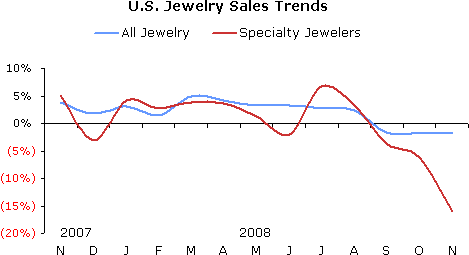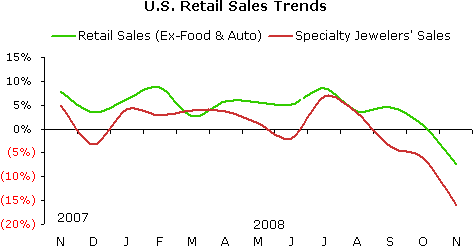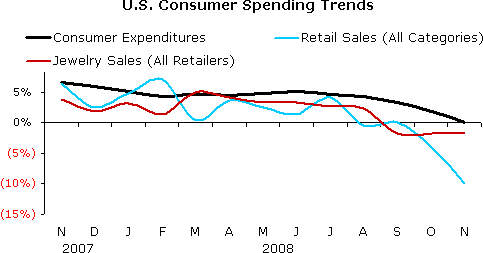IDEX Online Research: U.S. Jewelry Sales Down 16 percent in November
January 22, 09
It is old news that November and December jewelry sales in the U.S. market were awful. How awful? The government numbers for November just confirmed the worst: specialty jewelers’ sales fell by an incredible 16 percent. Total industry sales were down by just under 2 percent in November, according to preliminary government data; surely, that number will be revised significantly downward over the next few months.
Official sales numbers for December won’t be reported for another month; even then, they will be only preliminary results. But we know that they won’t be upbeat.
Here’s the retail sales scoreboard with the official U.S. government data. The numbers for September are final, though modest revisions can occur for up to six months after the numbers are published); the numbers for October may change a little; and, the numbers for November are subject to significant change of the next sixty days.

Source: Various
In addition to reporting very weak numbers for specialty jewelers’ November sales, the Department of Commerce revised downward October’s sales comparison for specialty jewelers to a decline of 6.1 percent from the preliminary number reported last month which should a more modest decline of 4.8 percent. September’s number – a 3.7 percent decline in sales – was not revised.
Specialty Jewelers Lose Market Share
Specialty jewelers posted a notable sales decline of 16.0 percent for the month of November versus preliminary figures which show that total jewelry industry jewelry sales were down only 1.8 percent. Specialty jewelers’ sales represent just under half of all U.S. jewelry sales. Thus, simple math reveals that jewelry sales were up among non-specialty retailers.
In short, even if the industry sales number – a decline of 1.8 percent – is revised significantly downward next month, it is clear that specialty jewelers lost market share to other retailers who sell jewelry, but for whom jewelry is not their primary business (like Wal-Mart, Kohl’s, Sears, and others). In recessionary periods, specialty jewelers tend to lose market share to discounters and others whose primary marketing message is “value.” Unfortunately, once specialty jewelers have lost market share, they never seem to regain it.
There is some good news in the government data: the jewelry industry gained market share when compared to all retail categories. Total retail sales (all goods, including food and automobiles) posted a decline – 9.9 percent – in November, dragged down by weak sales in virtually all categories. Total industry jewelry sales were down only 1.8 percent.
The graph below compares specialty jewelers’ sales trends to total jewelry sales trends in the U.S. As the graph clearly illustrates, jewelry sales at specialty jewelers have been on a roller coaster ride for the past year. After dipping in November and December, jewelry sales posted a modest recovery in January, a small dip in February and a modest recovery in March and April. In May, jewelry sales gains weakened substantially for specialty jewelers, with another major drop in June. Clearly, Mother’s Day (in May) was weak for specialty jewelers, but about normal for other retailers who sell jewelry. July sales for specialty jewelers rose significantly. Since then, they have been sliding down a slippery slope.

Source: US Dept of Commerce
The graph below summarizes sales trends for all retail goods (green line) excluding food and automobiles versus specialty jewelers’ sales (red line). When food and auto sales are excluded, the remaining retail categories posted a sales gain of 7.5 percent in November. When food and auto sales are included, retail sales were down 9.9 percent for the month, as previously indicated.
We eliminate “automobile” sales because they are driven largely by consumer incentives. Over the long term, auto demand trends are an important indicator of consumer vitality; however, on a month-to-month basis, auto demand is dependent on manufacturers’ incentives such as zero percent financing, cash-back offers and other deals. Food sales are far less cyclical and can mask changes in consumer demand; thus, we eliminate them, too.

Source: US Dept of Commerce
Consumer Spending Continued to Slow Notably in November
As inflation has slowed, growth of consumer expenditures has slowed from the first half of 2008. During November, consumer expenditures for all goods and services were flat, when compared to the prior year. This represents a steady decline since June’s 5.1 percent gain, a point when the fires of inflation were most threatening. Further, it is a sharp decline from October’s gain of 1.9 percent.
What is behind the slowing of consumer expenditure growth? As the graph below shows, total retail sales growth has taken a dive since the early Fall. Spending on big-ticket durables – often financed on credit – has suffered the most. Consumer expenditures on services also slowed modestly.
The graph below summarizes trends in American’s total spending, retail sales of all goods and expenditures on jewelry. It is clear that dismal automobile sales in the U.S. market are having a dramatic negative impact on total retail sales. Automobile sales in 2007 were just over 20 percent of total retail sales; thus, it is clear why they have such an impact on total retail sales trends. And, it should be obvious why we typically eliminate them, when we analyze U.S. retail sales. Automobile sales are driven largely by the “deal-of-the-day,” as we noted above.

Source: US Dept of Commerce
Jewelry Sales Forecast Revised Significantly Downward
It should come as no surprise that we are significantly revising our jewelry sales forecast for 2008 downward. We feel like we’ve been chasing an illusion: the moment we think we have a grasp on the economic situation, something new crops up, similar to the many-headed Hydra. And, frankly, we’re frustrated that we haven’t been more on target.
However, we recently saw an article in the Washington Post titled “Grasping at Tea Leaves: So You Can’t Predict Hits. Neither Can Anyone Else.” Here are a few quotes from the article. “Humans love to make predictions – whether about the movement of stars, the gyrations of the stock market, or the upcoming season’s hot color. Unfortunately, the predictions most of us make will be wrong.”
The article states: “Why is predicting so difficult? Well, for lots of reasons, but two fundamental ones stand out. First, individuals are much harder to predict than they seem, not because people are infinitely complex, but because how we are apt to behave depends on subtle details of the situation, according to scientific studies. Second, social phenomena are never just the product of individual people making decisions, but emerge out of many people making decisions in conjunction with each other.”
The article goes on to cite several psychological experiments which illustrate that, in fact, we really don’t have a clue about what will happen in the next nanosecond.
The article concludes: “So why do we still think we can forecast future events? [Humans] are so deeply attached to the idea of prediction that even when we make mistakes, we feel as if we could have predicted the future correctly, if only we’d paid attention to the right information. The usual trick we use to maintain this illusion is to find someone who did foretell the outcome correctly, and assume that if only everyone had known what this person knew, we’d all be okay. It’s a great trick, and it almost always works, because at any given time there are so many people making predictions about so many things that no matter what happens, it is almost certain that somebody somewhere will have said it would.”
We rest our case. We’ve seen people crowing about how they predicted the current financial crisis. Our comment: a stopped clock is right twice a day. Everyone gets lucky occasionally.
Given these comments, you’d think we’d give up on making forecasts. There’s not a chance of that: it is too ingrained in our blood.
So, once again, we’ll roll the dice with some help from history, dampen our finger and hold it up to see which direction the wind in blowing, and charge ahead at full speed.
- Our forecast for U.S. jewelry industry sales calls for 2008 revenues to be down about 4 percent. That’s based on a decline in December sales of 15 percent or so. If December sales deviate from that number, then our forecast will necessarily change, too. Even if sales decline by 4 percent or so, it won’t be as bad as 2001 when jewelry sales in the U.S. market declined by 5 percent. Be thankful for small favors.